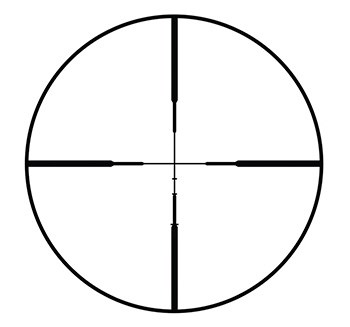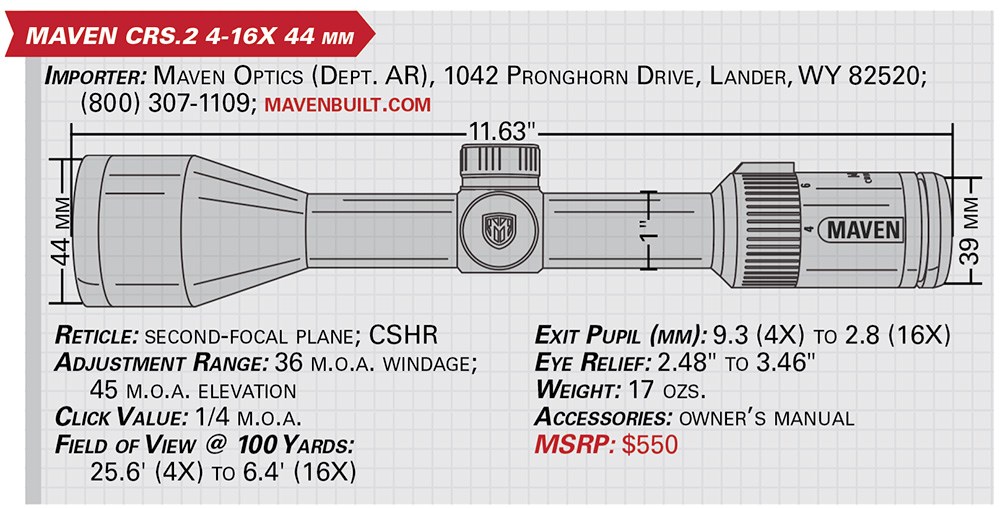
By cutting out the middleman, Maven Optics’ direct-to-consumer business model has been a key to the company’s success, as it has allowed the Wyoming-based company to offer first-rate products at price points that might otherwise suggest questionable quality. The firm’s latest addition is the CRS.2, a 4-16X 44 mm riflescope that offers game-busting glass without busting a budget.
The CRS.2 offers a wider magnification range than the 3-12X 40 mm CRS.1, while retaining the same award-winning fully multi-coated C-series glass that has put the company on the map. A larger 44 mm objective lens also gathers more light and provides the user with a wider field of view. These differences are most starkly noticed at dusk and dawn, which are frequently the most important times during a hunting venture.
Maven’s CRS.2 utilizes a 1" main tube of solid aluminum, which allows for mounting solutions low to the bore axis while still providing more than enough elevation adjustment for shots at typical hunting distances. Stretching out beyond point-blank range is aided by the CSHR reticle, which provides as much as 80 minutes of angle (m.o.a.) of elevation adjustment without touching a knob. To that end, we mounted our test sample to a Remington 700 using a 20-m.o.a.-canted Picatinny rail and inexpensive scope rings that can be found at nearly any firearm retailer. The process was straightforward, and after a simple bore sighting, we were able to conduct live-fire testing.
 We limited our range time to the early morning hours to help mitigate wind drift and mirage. Our testing began by establishing a 100-yard zero, which required only a few shots to complete. During this process, testers noted that the 1/4-m.o.a. clicks were remarkably crisp and that the side parallax knob was true to scale. After zeroing, we were able to reset the turrets simply by loosening two screws and slipping the drum. When finalized, we counted more than 30 m.o.a. of leftover elevation adjustment, leaving us enough to dial in for most hunting scenarios.
We limited our range time to the early morning hours to help mitigate wind drift and mirage. Our testing began by establishing a 100-yard zero, which required only a few shots to complete. During this process, testers noted that the 1/4-m.o.a. clicks were remarkably crisp and that the side parallax knob was true to scale. After zeroing, we were able to reset the turrets simply by loosening two screws and slipping the drum. When finalized, we counted more than 30 m.o.a. of leftover elevation adjustment, leaving us enough to dial in for most hunting scenarios.
Although dialing the elevation is always an option, the CRS.2 isn’t intended for it. Instead, the reticle has markings for five-, 10- and 20-m.o.a. holdovers. As its reticle is set in the second focal plane, these values are only accurate at its highest magnification setting—they must be doubled at 8X and quadrupled at 4X. We tested the reticle’s accuracy by placing a sheet of 1" graph paper at 100 yards, which confirmed that the reticle was regulated properly. Our final mechanical test was “shooting the square,” in which we dialed 10 m.o.a. between each corner, firing a confirmation shot at each one to ensure everything tracked correctly. The result was four proportionately spaced groups that were well within the typical accuracy consistency of our test firearm and the ammunition we used for evaluation.
With the bench work behind us, the group turned to real-world testing by using the CRS.2 in various field shooting positions. Most found the eye box to be forgiving enough to accommodate the different placements of the cheek along the comb caused by the standing, sitting and prone positions. We did notice that the lower the magnification, the more forgiving it was, but this is typical of all variable-power riflescopes. Overall, the eye relief was enough to fire the rifle in all of these positions without sustaining a blow to the eye, which is all that truly matters.
The Maven CRS.2 checks all the boxes that we look for in an affordable hunting scope. This includes proper color transmission, a quality that is often sacrificed to meet a dollar mark. We found the turrets to be user-friendly, the adjustments to be repeatable, and the overall design to be simple and comfortable to use. This optic is sure to get your season off to a good start and will likely hold up for a lifetime—but, if not, Maven offers an unconditional lifetime warranty on all of its optics.





































